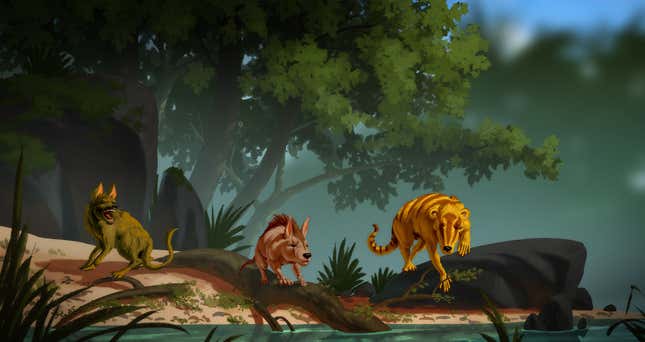
Paleontologists have found a bed of ancient mammal bones amid the dry, brush-covered landscape of Southern Wyoming. Three of those fossil finds belong to previously unknown species, and all the animals on the site paint a different picture about mammalian evolution in the wake of the dinosaurs’ demise after the devastating asteroid strike 66 million years ago.
The mammals on the site date back to the early Puercan—basically, the few hundreds of thousands of years that followed the asteroid’s collision with Earth. The three new species are Miniconus jeanninae, Conacodon hettingeri, and Beornus honeyi; all were in part named for the paleontologists who dug them up, though the last was also named after Beorn, a character in The Hobbit that can shape-shift into a bear. B. honeyi is the largest of the three new species, being about the size of a cat. The species were differentiated by their mandibles and teeth.
“Prior studies on North American mammal faunas from the first ~320,000 years following the mass extinction event had found small rat- to mouse-sized mammals that were fairly generalized in molar morphology. This led to the understanding that mammals were still recovering, and not rapidly diversifying, after the mass extinction event,” Madelaine Atteberry, a paleontologist at the University of Colorado, said in an email. Atteberry is the lead author of a new study describing the fossils, published in the Journal of Systematic Paleontology.
“However, the earliest Paleocene fauna in the Great Divide Basin in Wyoming, where our new mammal species are from, is a different story,” Atteberry added.” It has more diversity than what we would predict for this time period, which suggests that we cannot really generalize mammalian recovery after the dinosaur extinction.”

The fossil site was excavated by Jim Honey, Jeannine Honey, and Malcolm McKenna between 2001 and 2011, after it was mapped by Robert Hettinger of the U.S. Geological Survey, whose name is attached to the recently described Conacodon hettingeri. Now awash in dry sandstone, the region was a floodplain in the days of these ancient mammals and was covered in intertwined streams and rivers. Over the decade of work on the site, paleontologists found over 420 mammalian fossils. How so many fossils ended up in one place is still uncertain, though one of the team’s theories is that parts of the river would dislodge sediment, trapping animals (alive and dead) that eventually fossilized.
All three of the new discoveries are condylarths, a type of ancient mammal whose descents eventually produced modern ungulates: animals like camels, hippos, horses, and rhinoceroses. Atteberry said in a release that the diversity of these new species showcases how mammals took the dinosaurs’ extinction in stride, capitalizing on the larger animals’ absence by developing new food sources and expanding into new environments.
It’s likely that more species from the fossil deposits will be described—paleontologists haven’t yet had the time to sort through the hundreds of bones that collected there. We’re hoping for even bigger ancient mammals, as it seems that our earliest relatives wasted no time in growing larger and bolder once their dinosaur overlords were taken care of.
More: These Mole-Like Creatures Lived Under the Feet of Dinosaurs